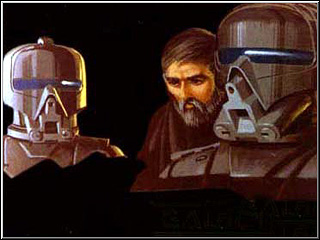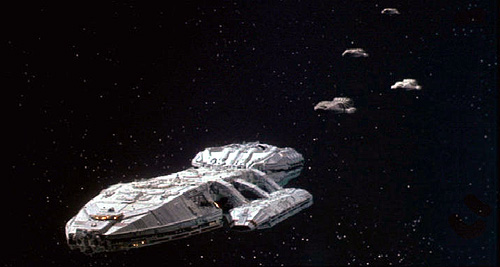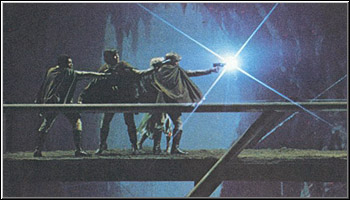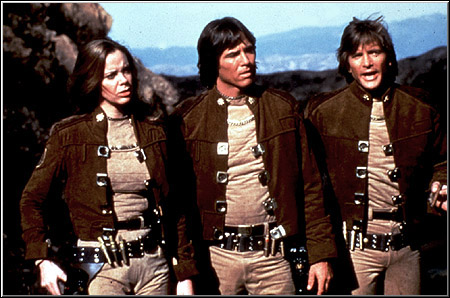
“There are those who believe that life, here, began out there …”
On September 17, 1978, those words heralded the birth of a science fiction revolution, the premier of a series destined to become a television and science fiction icon: Battlestar Galactica. An epic in the making, Battlestar Galactica brought big-screen production techniques and sensibilities to television. The special effects were state of the art and awe-inspiring, supervised and created by John Dykstra and Industrial Light and Magic, who were responsible for effects in the Star Wars movies. The sets were grand in scale, the cinematography was movie-quality, and the effect on the small screen was unique. The premier of Battlestar Galactica drew record-breaking ratings for a TV science fiction production.

Creator Glen A. Larson and his team used inspirations from our own varied history, religions, and cultures to build the universe of Battlestar Galactica. He drew inspiration from his own Mormon faith, as well as from the writing and designs of ancient Egypt, ancient Greece, and ancient Asia, from the Romans, Assyrians, Hindus, and their respective mythologies. The inspirations included, as well, the speculative “ancient astronaut” theories of people like Eric Von Daniken and Zacharia Sitchen. They strove to create an alien, human society that could have come from the same roots as our own world.

Universal Studios, inspired by the runaway success of Star Wars: A New Hope, committed what was said to the largest budget ever for a science fiction television production; “leaked” information hinted that the studio spent over One Million Dollars per episode, unheard of in 1978.

But, from the start, the production was beset with problems. Battlestar Galactica had originally been envisioned as a miniseries, perhaps to be followed by a series of TV movies; the executives, however, wishing to cash in on the unexpected popularity of Star Wars, pushed the production into a weekly series, which made the writers scramble for stories and caused constant headaches for the staff and crew. As a result came episodes that echoed many of the popular themes of the day, including Westerns, WWII epics, and Cold War politics. As the production progressed, scripts were often provided to the actors moments before they were to go before the cameras. The time pressures, as well as the expense of the special effects (never a popular situation with cost-conscious executives), meant that some of the effects shots had to be reused, frequently more than once in an episode. Each 48 minute episode of Battlestar Galactica took at least seven days to produce despite cost and time-saving measures such as the reuse of effect shots and “stock” footage; it was not uncommon that an episode was delivered to the network on Saturday night for the Sunday night broadcast.
Also, Fox Studios filed a lawsuit alleging Universal had copied the plot from Star Wars. Universal countersued, claiming their robots were taken from Silent Running. But in a June 1982 article in the now-defunct magazine Fantastic Films, investigative journalist William J. Adams alleges that this lawsuit was nothing more than a publicity stunt to increase interest in both franchises. There is no record of any attempt to halt production, no record of any settlement; he states that once the headlines stopped the lawsuit simply disappeared (not entirely true, as it turned out; on appeal, the Court found for Universal – 2 or 3 years after the show was canceled). However, the lawsuit (together with an unfortunately un-informed article by a Time Magazine reviewer) did have the unfortunate effect of leaving Battlestar Galactica perpetually – and inaccurately – labeled a “rip-off”.

Still, the show and its characters did develop as the weeks passed; the endearing rogue Starbuck, the solid and reliable Apollo, the wise leader Adama, and all the other characters viewers came to know and love; Athena, Sheba, Boomer, Jolly, Boxey, and the rest. The story emphasis began to shift from exciting space battles, the literal “fight to survive”, to more thoughtful fare, although no less life-and-death, and no less exciting. It was campy in spots, certainly, but fully deserves its status as a science fiction classic.
And Battlestar Galactica was a success. It made money for the studio and for ABC. It was consistently among the top-rated shows on television.
They canceled it anyway.
ABC-TV may have been making a profit on Battlestar Galactica, but apparently it wasn’t enough. According to Mr. Adams’ article, the network manipulated the schedule, preempting or moving the program in a deliberate attempt to kill it because the profit margin for science fiction wasn’t enough (see a reprint of the complete article HERE.)
Fans reacted with outrage. ABC had not counted on the fan loyalty to this show; not since Star Trek had been canceled had such an uproar been made. But the executives, after sending out misleading signals, still had no desire to maintain a sci-fi show with its higher production costs. They opted to create a low-budget version of Battlestar Galactica, which was called Galactica 1980. Doomed from the start by cheap production values, poor characterizations, and a time slot designed to limit the audience, this series was an immediate ratings failure and did not survive the full season.

– written by John Pickard
Select your Portal: